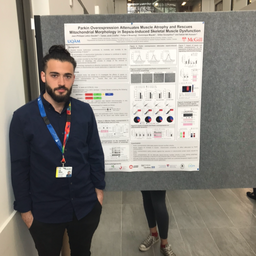Preliminary Results on Novel Gene Involved in Regulating Differentiation of C2C12 Myoblasts
My Session Status
Part of:
When:
11:30 AM, Monday 23 Nov 2020
(1 hour)
Where:
Virtual session
This session is in the past.
The virtual space is closed.
MYTHO: A Novel
Regulator of Muscle Cell Differentiation
Tomer Jordi Chaffer1,2, Jean-Philippe Leduc-Gaudet1,3, Felipe Eduardo Broering1, Dominique Mayaki1, Marco Sandri4*, Gilles Gouspillou3* and Sabah NA Hussain1** These authors contributed equally to this work as senior authors
1Meakins-Christie Laboratories, Department of Medicine and Division of Experimental Medicine, McGill University, Québec, Canada,
2Department of Biology, Acadia University, Nova Scotia, Canada,
3Département de Sciences de l’activité physique, Faculté des Sciences, UQAM, Québec, Canada,
4Department of Biomedical Science, University of Padova, Padova, Italy.Rationale: Skeletal myofibers are large multinucleated cells formed by the fusion of hundreds of myoblasts. Development of skeletal muscle cells is a highly complex process controlled by multiple intracellular proteins. Muscle satellite cell activation, proliferation, differentiation, and fusion into new myofibers appears to be necessary for repair and maintenance of skeletal muscle health throughout life. However, major gaps in our understanding of the cellular and molecular mechanisms that regulate myogenesis still remain. Using GEO database (GDS3159), we found that the expression of D230025D16Rik was increased in reversine-treated C2C12, a model of myoblast dedifferentiation, suggesting that D230025D16Rik might play a role in myogenesis. However, to date, whether D230025D16Rik can impact the expression of genes involved in myogenesis has never been investigated.Objective: To define whether knocking down D230025D16Rik alters the expression of myogenic genes.
Methods: D230025D16Rik was knocked down using siRNA in undifferentiated C2C12 cells. Scramble siRNA was used as negative control. A microarray (Clariom™) was performed on samples collected 48hrs after transfection.
Results: Gene ontology analyses revealed that several pathways were enriched upon D230025D16Rik knock down in C2C12 myoblasts, including stem cell differentiation and regulation of cellular response to growth factor stimulus. In response to D230025D16Rik knockdown, we observed a significant increase in the mRNA levels of MyoD and Myogenin during early differentiation of C2C12 myoblasts.
Conclusion: Our preliminary data indicate that knockdown of D230025D16Rik increases the expression of myogenesis-related genes. Experiments are currently underway to assess whether knocking down D230025D16Rik alters the proliferation, differentiation, and fusion of C2C12 myoblasts.
Tomer Jordi Chaffer1,2, Jean-Philippe Leduc-Gaudet1,3, Felipe Eduardo Broering1, Dominique Mayaki1, Marco Sandri4*, Gilles Gouspillou3* and Sabah NA Hussain1** These authors contributed equally to this work as senior authors
1Meakins-Christie Laboratories, Department of Medicine and Division of Experimental Medicine, McGill University, Québec, Canada,
2Department of Biology, Acadia University, Nova Scotia, Canada,
3Département de Sciences de l’activité physique, Faculté des Sciences, UQAM, Québec, Canada,
4Department of Biomedical Science, University of Padova, Padova, Italy.Rationale: Skeletal myofibers are large multinucleated cells formed by the fusion of hundreds of myoblasts. Development of skeletal muscle cells is a highly complex process controlled by multiple intracellular proteins. Muscle satellite cell activation, proliferation, differentiation, and fusion into new myofibers appears to be necessary for repair and maintenance of skeletal muscle health throughout life. However, major gaps in our understanding of the cellular and molecular mechanisms that regulate myogenesis still remain. Using GEO database (GDS3159), we found that the expression of D230025D16Rik was increased in reversine-treated C2C12, a model of myoblast dedifferentiation, suggesting that D230025D16Rik might play a role in myogenesis. However, to date, whether D230025D16Rik can impact the expression of genes involved in myogenesis has never been investigated.Objective: To define whether knocking down D230025D16Rik alters the expression of myogenic genes.
Methods: D230025D16Rik was knocked down using siRNA in undifferentiated C2C12 cells. Scramble siRNA was used as negative control. A microarray (Clariom™) was performed on samples collected 48hrs after transfection.
Results: Gene ontology analyses revealed that several pathways were enriched upon D230025D16Rik knock down in C2C12 myoblasts, including stem cell differentiation and regulation of cellular response to growth factor stimulus. In response to D230025D16Rik knockdown, we observed a significant increase in the mRNA levels of MyoD and Myogenin during early differentiation of C2C12 myoblasts.
Conclusion: Our preliminary data indicate that knockdown of D230025D16Rik increases the expression of myogenesis-related genes. Experiments are currently underway to assess whether knocking down D230025D16Rik alters the proliferation, differentiation, and fusion of C2C12 myoblasts.
Who's Attending
sephora sallis
UQAM
Jean-Philippe Leduc-Gaudet
McGill
Elise Duchesne
UQAC
Felipe Broering
McGill
Nicolas Dumont
CHU Sainte-Justine
Benoit Barbeau
UQAM
Philippe Campeau
Université de Montréal




